by Coffee Kevin | Mar 12, 2015 |
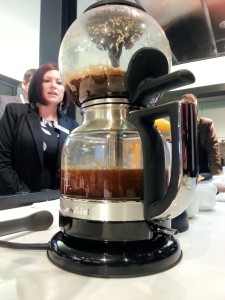 I keep saying that if you don’t get into coffeemakers, your coffee at home will never be great. The best trade show for the gear isn’t a coffee show at all – it’s the International Housewares Show.
I keep saying that if you don’t get into coffeemakers, your coffee at home will never be great. The best trade show for the gear isn’t a coffee show at all – it’s the International Housewares Show.
It’s where I discovered the Chemex, the Aeropress, KitchenAid’s legendary 4-cup, Bonavita, Technivorm and of course my first Bunn, the A10. Not bad for one event! They don’t really want consumers here. I get to go because I keep writing this blog and various articles. Even I used to get ignored because the sellers are always on the lookout for Macy’s buyers. Can’t blame them. I ask a hundred questions and might buy one, where department store buyers are going to buy a case for each store. It keeps me humble.
This year’s event had several new, innovative products. Let me give you a quick (by my standards) rundown. None are reviews. I sometimes look back at first-tastes and see them for the infatuations they are. I believe in long courtships regarding coffeemaker testing. 30 days is the minimum, and it reduces/eliminates new car smell, packaging, and gives me time to do old fashioned things like read the instruction book and tweak products a bit before shooting off my pen, figuratively speaking of course.
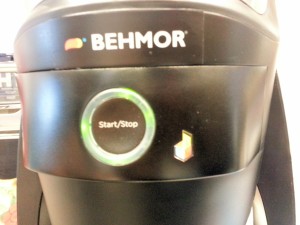 Behmor won the Innovation Award, Kitchen Electrics, International Housewares show award for Joe Behm’s Brazen Connected 8 Cup Brew System. I was perhaps the first to review the Behmor Brazen, so you already know its leading edge position among brewers for its variable temperature setting, variable pre-infusion times (you can actually brew same-day roasted coffee without foaming overflows!) and altitude settings, which likely mean nothing to New Yorkers or Chicagoans, but are the only way to achieve SCAA-recommended brewing temperatures in Denver. Joe won his award (which kept him from showing up at CoffeeCon NYC) for the brand-new “connected” version of his brewer.
Behmor won the Innovation Award, Kitchen Electrics, International Housewares show award for Joe Behm’s Brazen Connected 8 Cup Brew System. I was perhaps the first to review the Behmor Brazen, so you already know its leading edge position among brewers for its variable temperature setting, variable pre-infusion times (you can actually brew same-day roasted coffee without foaming overflows!) and altitude settings, which likely mean nothing to New Yorkers or Chicagoans, but are the only way to achieve SCAA-recommended brewing temperatures in Denver. Joe won his award (which kept him from showing up at CoffeeCon NYC) for the brand-new “connected” version of his brewer.
With the Behmor Connected you will be able to go online and download Counter Culture’s (or other roaster’s) recommended settings for his brewer. This means even more. I can envision barista champs blogging their favorite recipes and settings for coffees ala celebrity chefs (that they really are of course) and finally being able to achieve at home exactly what they are doing in the cafes. Meanwhile, it should double Behmor’s market because more casual consumers who just care about taste, not geeky tweaking, and give them easy downloads to load.
An interesting new startup is Brewista, the brainchild of Bonavita co-owner and inventor, Brian Gross. Brian is one of the great minds of coffee brewing. He talks faster than anyone I’ve ever known, and it’s all content. He’s establishing a coffee product innovation think tank, and future manufacturing site in Cheyenne, Wyoming! He’s releasing a line of simplified Bonavita products that will feature fewer features, and lower costs to bring things like their kettles to a wider audience. Brian is working on online interconnectivity with coffeemakers, which means more sophisticated brewing and simplified operation for sleeping early-morning operators. The thing that he was most excited about was his onsite coffee shop almond milk extractors for cafes. Of course, a home version cannot be far behind. Keep an eye on Brewista. Brian has a great track record with Bonavita, and among coffee’s best overactive imaginations.
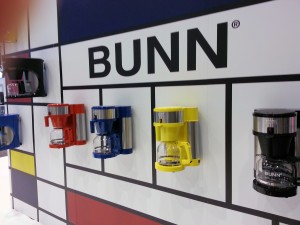 Bunn had a wall of colorful brewers. At first I thought they’d kidnapped an Italian designer and brought them to Springfield, but it turns out they were only for display. They did have their home Trifecta on hand. I can’t help continuing to believe they should sell those in a Bose-style direct program (the pricing/profit margins are too low for mainstream retailers, even so-called high end ones like Sur La Table or Williams-Sonoma). A Connected Trifecta has to be in the works, but if it is, they’re keeping mum about it. Hope they walked the show.
Bunn had a wall of colorful brewers. At first I thought they’d kidnapped an Italian designer and brought them to Springfield, but it turns out they were only for display. They did have their home Trifecta on hand. I can’t help continuing to believe they should sell those in a Bose-style direct program (the pricing/profit margins are too low for mainstream retailers, even so-called high end ones like Sur La Table or Williams-Sonoma). A Connected Trifecta has to be in the works, but if it is, they’re keeping mum about it. Hope they walked the show.
Bunn still makes the best tasting K-cup machine I’ve yet tried. It hits the 196°F mark easily, and, used in tea (pulse) mode, does a very nice cup. iCoffee is my single nod to K-cups. I lost interest in Keurig after they released the 2.0. It has the faults of the first generation, and some new bad habits like the locking mechanism that forces you to use mediocre coffees. Too bad too, because there are some good local roasters churning out fresher, higher quality K-cups. The Keurig 2.0 is not a bad machine, in fact it is amazing for what it does, but it was designed to expand its use for many beverages, soups etcetera. It makes good (not great) coffee.
iCoffee, brainchild of Bruce Burrows, who purchased the old Remington name (they used to be a high quality coffeemaker brand). The iCoffee does extract more thoroughly than Keurig’s or most other K-cup machines. And it uses any K-cup, just as Bunn’s does, so there’s no problem filling it with the really good ones coming out. Who’s got good K-Cups? La Minita’s own brand of K-Cups, made with proprietary filters made from surgical fabric and recyclable after peeling foil, are the best I’ve yet tried. I know K-Cups are under ecological and sensory fire, but they are market reality and, as Mc Alpin and Boyd’s have proven, can be made recyclable.
KitchenAid hosted a little reviewer party one morning at their nearby (it’s not that near) showroom. I was just wowed when KA Product Development Manager Meighan McLaughlin started brewing for me with their new Siphon (vacuum) coffee maker. It has automatic cycle, a permanent filter, and has a glass top, yet features steel reinforcement at the traditionally weak points. KitchenAid also has a new grinder, with claimed burr refinement. There’s even a new KitchenAid French press which operates on AA batteries.
 I’ve saved Oxo for last. Oxo makes a lot of rubber-sided kitchen hand tools. I have their can opener, and nothing else, but it works well. So what are they doing in the coffeemaker business? Apparently, according to their charming French Senior Product Manger, Claire Ashley, they decided to enter the coffeemaking market after analyzing the current one and realizing how mediocre most coffeemakers are. Obviously, CoffeeCompanion fans know this, and also know I simply ignore most of the ones that can’t extract properly, but having searched last year for my Consumer’s Digest report, I can say that likely 80% of the ones in mainstream department stores are genetic failures in the kitchen.
I’ve saved Oxo for last. Oxo makes a lot of rubber-sided kitchen hand tools. I have their can opener, and nothing else, but it works well. So what are they doing in the coffeemaker business? Apparently, according to their charming French Senior Product Manger, Claire Ashley, they decided to enter the coffeemaking market after analyzing the current one and realizing how mediocre most coffeemakers are. Obviously, CoffeeCompanion fans know this, and also know I simply ignore most of the ones that can’t extract properly, but having searched last year for my Consumer’s Digest report, I can say that likely 80% of the ones in mainstream department stores are genetic failures in the kitchen.
Oxo first showed me their grinder; that they showed me the grinder first is a good sign. It has a built-in scale and automatic shutoff by weight. The upper beans bin is removable and sealable. If it grinds properly, (only testing can determine this) they might really have a powerful entry. They are introducing two coffeemakers. First, the 1 liter one has a glass tube so water at its hottest never touches plastic (although the grounds holder is BPA-free plastic). They have also developed algorithmic internal software that allows you to do various batch sizes and still deliver the same grounds/water contact time. This results in consistent tasting brew, whether you make two cups or eight. If it works as promised, it’s a great feature.
The second model offers a larger 12 – 4.5 oz cup batch size. According to Ms Ashley, Oxo designers recognized the heating limitations creating enough pumped hot water to do this, which she says is impossible with current technology. So, they are heating all the water at once, and then release it at approved brewing temperature. Both brewers feature tubes to release brew at carafe bottom in order to mix coffee before pouring. An unusual innovation is a transformer feature where you can remove the boiler and use it as a water kettle. Exciting!
As Sherlock Holmes, and later Carly Simon, say: These are the good old days!
by Coffee Kevin | Jul 8, 2014 |
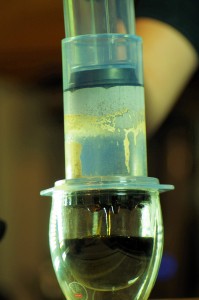 The Aeropress marks the longest I’ve ever waited for formally review a product. I met inventor Alan Adler nine or more years ago. We were introduced by then Bunn VP Aimee Markelz. Just to show how gracious some people can be even in an industry with such hot competition as coffeemakers, Ms Markelz was walking through the International Housewares show before showtime and spied this new coffeemaker. When I did my usual walkaround at Housewares she handed me a slip of paper with the Aeropress booth number on it. She told me she thought I’d find it interesting. I did. I do.
The Aeropress marks the longest I’ve ever waited for formally review a product. I met inventor Alan Adler nine or more years ago. We were introduced by then Bunn VP Aimee Markelz. Just to show how gracious some people can be even in an industry with such hot competition as coffeemakers, Ms Markelz was walking through the International Housewares show before showtime and spied this new coffeemaker. When I did my usual walkaround at Housewares she handed me a slip of paper with the Aeropress booth number on it. She told me she thought I’d find it interesting. I did. I do.
The reason I waited so long to review it? I guess I took it for granted. But now I feel a little guilty and negligent. Or it’s such an open-ended device it all depends on how you use it. Honestly, I can’t tell you why. Is it because it has no engine, no water heater? That can’t be. Neither does the Sowden SoftBrew nor does the Chemex. Is it due to it’s cost – as in low? Nope, I’ve reviewed the Melitta single cup, and I’ve packed three of them into knapsacks of my college bound sons.
So, let me stop the self analysis and proceed to make amends for my lengthy review time. The Aeropress, though wholly innovative and original in its design, seems to provide the features of all the world’s coffeemakers through time. Like a modern Hollywood film, it has elements of all that came before it in its genre. The Aeropress has some elements of the French press, namely the press, both in name and procedure. The Aeropress has elements of the Chemex, particularly in its filter and its brewing temperature recommendations. Finally it has elements with the vacuum or siphon coffeemaker, mainly its mass-compressed grounds puck.
The Aeropress is perhaps the ultimate flexible coffeemaker. It can be used conventionally, where it gives the impression of being a somewhat leaky manual drip maker. It can be inverted, placed upside down, its filter cap removed and it becomes a settling tank where coffee is steeped like a tea before its cap is replaced, it is flipped over and then pressed to completion. Which is it for me? I’ve spent several years in each camp. Finally (or just lately?)
I’ve settled on the conventional method. I believe I’d done this out of simplicity, and perhaps a little out of my desire to set the record straight on what I consider the Aeropress myth of being a leaky drip maker. When people pour a little hot water into the Aeropress and stir so that the grounds get plenty wet and are allowed to swell and settle before the press is used, a minute amount of water travels through the grounds and out through the filter and into your cup. There is nothing about this that is going to affect your coffee end result. It is no different than the initial drips of any drip coffee maker. Coffee is all about grounds/water contact time and nothing else.
Aeropress brewing temperature is, or should be, controversial. I know it’s manual so you can use whatever your lil’ water heatin’ vessel can provide. I have a fancy schmancy BonaVita kettle with dial and hold temperature settings. Inventor Alan Adler says Aeropress competitions tend to be won at brewing temps of 185°F for the super light roasted coffees and 175°F for medium to dark roasts. What does all this mean to the coffee industry, who’s fought so long and hard to convince us to brew hotter into their 10 degree (195F-205F) window? That’s a tough question and likely a subject for a different article. For the moment I’m going to use the ole’ reviewer copout #7 that we should view the Aeropress on its own terms. Of course you can use your Aeropress at whatever temperature you prefer, but after a number of tests in my kitchen, I’m inclined to operate mine at the light roast winning temperature: 185°F.
Speaking of roasts, here are some coffees that I tested:
- George Howell Coffee’s La Minita I got spectacular results with this coffee. Man that is one complex beverage as brewed in the Aeropress. Like a great symphony orchestra, La Minita’s Bill McAlpin is unable to create a bad note. This coffee, third wave light roast and all, is just a perfect match for the Aeropress. Did I hear chocolate? I know most coffees give this note at this brewing temperature, but it’s the quality of chocolate note that this coffee provides.
- Sight Glass Colombian Finca Alcatraz – I recently became smitten with this coffee in all brewing methods. I don’t know what to say except I just enjoyed its richness and cocoa and nougat notes. I admit I feel the lush fruit notes are boosted by moving the brewing temperature back into the 190°s.
- Counter Culture Finca El Puente Honduras – I couldn’t resist trying some coffee farmed by CoffeeCon presenters Marysabel Caballero and Moisés Herrera and their latest coffee. Counter Culture roasted it at the light end, although to be fair, not too light, which I found to be a perfect match for Alan’s observed 185°F brewing temperature. Okay, I probably sneaked up to 190°F. I got that black cherry flavor kick right away.
Conclusion: The Aeropress is just a wonderful brewer. If you are caught between gigs, you likely can afford it. It is easy to use, to clean up. And, it delivers an ultra clean taste, with plenty of viscosity but virtually no sediment. If this is the cup you seek, the Aeropress is a brewer used must have in your brewing arsenal. Period.
Photo note: Aeropress Inventor Alan Adler says, “I do like clear glass which reveals the flow (drip), but recommend a wide-bottom, sturdy mug like the attached pic.”
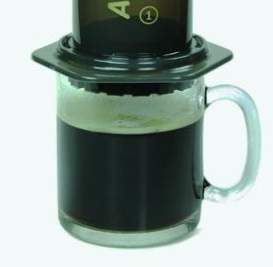
by Coffee Kevin | Nov 12, 2012 |
We are living in a golden age of coffeemakers. Just a short while ago I honestly could not say this, but today I can and the biggest innovations are happening in automatic coffeemakers. It used to be the Technivorm and Bunn, and the industry didn’t understand the Bunn, so it was really just the one machine among the elite. Today there are several that meet high enough standards to motivate me to write a comparison to help make up your mind. Please read the in-depth reviews as they appear, but I wanted to get something out to clarify them side by side.
Here is the current A list:
• Technivorm
• Bonavita
• Behmor Brazen
• Bodum
• Bunn Phase Brew
Each of these has the following traits in common:
• Meets goal of brewing in under 6 minutes contact time. The Bunn and Behmor machines take longer from the time you press the button, but that’s because they’re designed to heat the entire water amount first, but none over extracts like so many automatic drip machines from other manufacturers.
• Brews at industry standard brewing temperature: 200° F.
• Gets the grounds properly wet.
Here is a profile of each, containing my observations for each machine.
TECHNIVORM KB741
The Technivorm is the original automatic drip machine champ. It is the oldest engineering design. It has a well-earned reputation for performance and longevity. It gets the water almost instantly hot and stays there ruler flat. I’ve got one that’s twenty years old. It is discolored but still performs. You could get one and call it a day. Its only weaknesses are price ($300) and a less-than-perfect showering system. It’s nit-picking but the Technivorm sometimes leaves a few dry grounds or with ultra fresh grounds, they tend to swell up and then the water drips through the center. Technivorm fans own them for years and don’t notice or care or find hacks to overcome it. Strengths: The Technivorm is the best-built coffeemaker I’ve ever tested. It does not have a single lowest-bidder part in its makeup. The one I recommend has a patented tube that ensures all the coffee is evenly distributed as it brews and it works. $279 glass carafe/$299 thermos
BONAVITA
The Bonavita is really designed by Melitta in Europe, but since they license their name to Hamilton Beach in the US, an American stage name needed to be created. It has been accused of being a Technivorm knockoff, but if it is, it’s a knockoff at half the price. In testing I found it does meet the industry temperature standard of 200°F +-5°F but it does so over a wider variance. Whether this matters to you or not is a matter of opinion, but no, it is not exactly the same. It does actually outperform the Technivorm when it comes to water saturation of the grounds. In this regard it is the best coffeemaker I’ve ever tested. Weaknesses: Build quality okay, but longevity is unproven. Strengths: Price and overall cup quality and ideal water distribution. $129/$149 glass carafe/thermos
BEHMOR BRAZEN
The Behmor wins the award as the most innovative coffeemaker of all. Invented by Joe Behm (Behmor Coffee Roaster) this one has some unique and first-ever features. Fresh coffee foams up when hot water hits the grounds, a big problem for all automatic drip machines. This rise and fall takes a minute or more. Chemex and other manual method users watch this and wait to start pouring the rest of the water over the grounds. It makes a big difference in taste. The grounds just extract better once they’re settled. The Brazen can be programmed to get the grounds initially wet, then wait between one and four minutes before running the rest of the water through. The Brazen also lets you choose the brewing temperature, even outside the recommended temperature range. As far as I know, this is a first. The Brazen has you enter your location’s altitude when you set it up (just once, and it’s easy). I know that’s a first. Setting the brewing temperature makes a profound difference; not subtle at all. Best of all, these settings are really easy to access. It’s a geek’s dream maker, but anyone can use it, it works out of the box or after setup, and temperature can be adjusted before each brew if you like. Definitely the choice for those who need absolute control and like to vary the taste for each coffee they try. $199 thermos only
BODUM BISTRO POUROVER 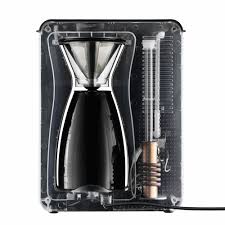
Bodum has long been associated with the French press, but they’ve done some other coffeemaker designs, including an electric vacuum maker. The Bodum Bistro is their first foray into the world of automatic drip. Rumor has it they simply sourced the same heating element as Technivorm. Not original, but a good choice. It has a see-through design that’s as sexy as any actresses’ Academy Awards frock (to me anyway). I’ll say it right now: It’s the best looking coffeemaker made on the planet. Weaknesses: It has a slightly tight brewing chamber. I found it can get messy with just-roasted coffee, unfortunately the kind I use. By carefully measuring the grounds you can eliminate this, but it takes trial and error with measuring and grind tweaking. Cost matches the Technivorm and its durability is yet unproven. Strengths: Beauty. $299 thermos only
BUNN PHASE BREW
Bunn is the sleeper of the group. Bunn has always met the industry specs, but their earlier brewers met consumer resistance to an always-hot water feature, good for fast brewing, but perceived wasteful. This latest one breaks with tradition. No water is stored or kept heated. You add water to start making coffee just like everyone else’s. The Phase Brew has grown a quiet reputation as Bunn’s best-ever consumer brewer. Like the Behmor Brazen, it heats all the water to desired temperature, then releases it over the grounds. It consistently brews at 200°F just like a Technivorm, and gets all the grounds wet; just does so at a lower-than-Technivorm cost. The Phase Brew has a sleeker design than earlier Bunn models. Weaknesses: Difficult to figure out how to open and close their thermal carafe. I made coffee, had to grab the phone, and came back to find my PhD friend struggling to pour himself a cup. Strengths: Top rank coffeemaker, but the price is heavily discounted due to Bunn’s wide distribution and being undervalued by marketplace. Shhh, Bank of America got a break. Why shouldn’t you? $99 Glass carafe/ $120 thermos
DECISIONS, DECISIONS
I’d be happy with any of the brewers in this group. Not one of them need apologize for being an automatic drip machine. Although I can already hear manual drip enthusiasts saying none could replace their Hario or Chemex, you might be surprised after tasting some of the coffee I’ve had from each of these machines. I know that this or that function might be more controllable using manual methods, but any of these can produce an excellent cup of coffee. In some ways they offer more control, and certainly more consistency. So here you have it… the closest I get to offering a shopper’s guide.
To the manufacturers who aren’t listed. I apologize but I will add anyone’s machine as they qualify. They must brew a full batch in under 6 minutes, get the water heated to the above-stated specification and get all the grounds equally wet.
by Coffee Kevin | Oct 21, 2011 |

Blonde Coffee Moment
This was heightened for me reading a sound byte by Robert Passikoff of Brand Keys, a New York City (marketing?) consulting firm. He said, “”It’s just good marketing. If virtually half the people say that the more European, heavier-tasting coffee is not to their liking, why not (do it)?” I could take Mr Passikoff to task for calling it more European – not, the Starbucks roast originated in San Francisco (and Alfred Peet). But, what makes me bristle more is calling it marketing. It might be paying attention to consumer trends but that is not marketing.
Good marketing is leading. Roasters such as George Howell, Oren’s Daily Roast, Counter Culture and Intelligentsia are light roast’s marketing champs. They forged ahead when angel investment groups would have looked cross-eyed that any small-time coffee guys were bucking the Starbucks “secret sauce”, the black roasted product with umami (savoriness). Starbucks marketing was so good so early and it convinced people that overroasted coffee was a virtue, that the only reason it was light roasted was to save weight loss during roasting. Still, sometimes people unchurched in the nomenclature of the coffee industry would simply say Starbucks was too strong, and this was even true among some specialty coffee folks.
Coffee strength alone was never the real problem with Starbucks, although it might seem like it at first glance. Many years ago, after Starbucks first came to rule the Evil Empire of consumer coffee, they attempted briefly to follow the Specialty Coffee Association’s hefty brewing formulas. Consumers collectively gagged and, again in a response to consumers, Starbucks hastily backed off in the brew basket. They made it less strong, but it might be argued that consumers were less in angst about the strength than that they were really tasting the stuff for the first time under the full-strength taste spotlight. The reality and the the real problem was roast. Starbucks came out a while back with a Pikes Roast, which attempted to bring their roast up a few notches lighter. It goes to show just how dark was Starbucks roasting that some, including me, were unable to appreciate Pikes as anything approaching a light roast.
The coffee business likes to pat itself on the back for marketing. It’s as if it doesn’t really believe in its product and are privately saying, “Can you believe people actually like this stuff”? There are two areas where the market (not to say “marketing”) has gone and in both these directions, Starbucks is a follower. So-called slow brew methods, such as Chemex, Hario and other drip techniques have replaced espresso with coffee aficionados. Truthfully, Starbucks never sold espresso anyway but café lattes. Slow brew means filtered coffee, which is really the specialty coffee world’s “special sauce”. Not only is Starbucks burning off the most prized flavors in their roast. They finish it off using an espresso machine. Espresso was invented as a socialist experiment to shorten the Italian coffee break and to bring forth flavors from some of the world’s least costly coffees, not exactly in lock step with the flavor seduction a Chemex can achieve with high-end beans.
Lately, espresso has become the proletariat drink and single-origin slow-brew drip the beverage choice of the literati. Witness Oliver Strand’s precious New York Times columns. Slow brew drip using some single family farm’s beans is cool. This movement was started by high-end consumers, independent farmers who learned to market their coffees using direct trade and, lastly, those high-end coffee guys previously named who stuck it out after Starbucks had attacked them and taken a good portion of their market share. Now consumers flock to them and places like Grumpys, Blue Bottle, Stumptown, all delivering a much lighter roast, and most highlighting the virtues of a small personal pot of coffee brewed per guest or couple.
Meanwhile, Starbucks has done a great job creating community centers. They are modern suburbia’s equivalent of Target, with the same uniformity. They can rightfully claim to have invented or at least won in this competition. The new roast is different. It will allow consumers to have it their way, which is a lighter way. I wish Starbucks well in joining them with the Blonde roast. It might be considered flexible and a smart response. But, it was not a marketing coup.
©2011 Kevin Sinnott All rights reserved.
by Coffee Kevin | Oct 14, 2011 |
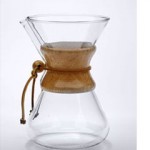
The Chemex is both a coffee brewer and an artwork. Few coffee brewers have the ability to show to an audience like this brewer. It’s even earned a place at the Smithsonian. It’s so delightful to look at that it’s easy to overlook that it’s a fine coffee brewer that offers a unique flavor profile.
How It Works
The Chemex uses a thick laboratory-grade paper filter. If you try to use Melitta-style filters in a Chemex, the water will run through too quickly. The paper is part of the method. It asks as a flow regulator. The idea is to fill the Chemex with coarse ground coffee and let it soak as the thick paper slows the water’s movement through the coffee. In this way, it offers and almost-French press-like soaking to the grounds. But, most Chemex aficionados suggest tiny hot water pours, adding just enough to completely cover the grounds.

The thickest filter paper ever... let's you brew stronger, which surprises a lot of people.
Tests
I made coffee using very coarse grounds, identical to what I’d use in a French press or percolator. This is counterintuitive to drip making, but the thick paper demands it. If you grind too finely, the combination of paper density and grind will slow your drip rate so much, you’ll end up with very strong, bitter coffee, although there will be no sediment. I heated the water to boiling and then removed it. In about a minute the water was 200 degrees Fahrenheit. That’s a good temperature to pour into the Chemex. The Chemex inventor, Dr. Peter Schlumbohm, believed that most coffee brewers (especially the vacuum) brewed at too high a temperature. The Chemex is designed to brew at standard or below temperatures. While I got good results at up to 200F, I often preferred the coffee brewed at around 190, which is technically 5 degrees below industry standards. Let’s just say this: don’t pour the water in once it’s boiling; you won’t like the results.
The temperature curve reflects the gaps between pours. As you can see, it’s hard to determine the exact contact time between the water and the grounds. One reason for the distinctive flavor of the Chemex might be the wide temperature variance once the water is poured in, without any more hot water joining it until that amount has gone through the grounds. Another reason may be the coarse grounds. The thick paper filter is almost certainly a factor. While critics may claim the Chemex filter holds back important flavor oils, I would not agree without some evidence. The cup profile does not indicate anything less than a stellar cup of coffee. In fact, I think I can make stronger coffee with the Chemex with no bitterness at least partly due to its filter. If a wine-like viscosity is what you want in your cup, the Chemex is your brewer.
Grind
The Chemex works by trial and error. It is difficult to calculate the contact time, as you really have a number of contact times, due to the practice of pouring small amounts of hot water and allowing it to cycle through the filter bed before pouring in the next one. The best starting point it simply to use a coarse grind and not-too-hot water.

Coarse ground, like Kosher salt, because the filter controls contact time, not the grind.
Measurements
I use forty grams of ground coffee in the so-called six cup Chemex. I own the larger one too, the eight cup. I use seventy-two grams of ground coffee and I grind is slightly coarser. I use less and grind coarser because the ground coffee bed is deeper, meaning the contact time is automatically longer.
Water temperature
An interesting point how hot the succeeding pours are. Most manual drip users boil the water, then let it come off the boil and then pour it in without reheating it. As Oren Bloostein told me, he continuously keeps the water at near boiling. I’ve done it both ways, and am unconvinced that one way is inherently right versus the other. I suggest you try both and decide.
Cleanup is simpler with the Chemex than any other brewer I’ve used. You simply toss the paper away. If you compost, you toss the remove the grounds and toss the filter. The glass maker rinses easily — nothing to scrub.
Conclusion
The Chemex is the most attractive manual drip maker ever made. It is a manual drip maker, which means it’s more work to make the coffee. Even though I do, I can understand others claiming they don’t want to make manual coffee while getting ready in the morning. Its cleanup is so simple, and once you get your measurements and grind down, it’s really quite an easy brewer. The only thing left is how to keep the coffee warm. I suggest the cost is low enough that you buy two sizes and make the right amount for a half hour, and spring for the glass top that keeps the heat in.
I strongly recommend the Chemex brewer.
 I keep saying that if you don’t get into coffeemakers, your coffee at home will never be great. The best trade show for the gear isn’t a coffee show at all – it’s the International Housewares Show.
I keep saying that if you don’t get into coffeemakers, your coffee at home will never be great. The best trade show for the gear isn’t a coffee show at all – it’s the International Housewares Show. Behmor won the Innovation Award, Kitchen Electrics, International Housewares show award for Joe Behm’s Brazen Connected 8 Cup Brew System. I was perhaps the first to review the Behmor Brazen, so you already know its leading edge position among brewers for its variable temperature setting, variable pre-infusion times (you can actually brew same-day roasted coffee without foaming overflows!) and altitude settings, which likely mean nothing to New Yorkers or Chicagoans, but are the only way to achieve SCAA-recommended brewing temperatures in Denver. Joe won his award (which kept him from showing up at CoffeeCon NYC) for the brand-new “connected” version of his brewer.
Behmor won the Innovation Award, Kitchen Electrics, International Housewares show award for Joe Behm’s Brazen Connected 8 Cup Brew System. I was perhaps the first to review the Behmor Brazen, so you already know its leading edge position among brewers for its variable temperature setting, variable pre-infusion times (you can actually brew same-day roasted coffee without foaming overflows!) and altitude settings, which likely mean nothing to New Yorkers or Chicagoans, but are the only way to achieve SCAA-recommended brewing temperatures in Denver. Joe won his award (which kept him from showing up at CoffeeCon NYC) for the brand-new “connected” version of his brewer. Bunn had a wall of colorful brewers. At first I thought they’d kidnapped an Italian designer and brought them to Springfield, but it turns out they were only for display. They did have their home Trifecta on hand. I can’t help continuing to believe they should sell those in a Bose-style direct program (the pricing/profit margins are too low for mainstream retailers, even so-called high end ones like Sur La Table or Williams-Sonoma). A Connected Trifecta has to be in the works, but if it is, they’re keeping mum about it. Hope they walked the show.
Bunn had a wall of colorful brewers. At first I thought they’d kidnapped an Italian designer and brought them to Springfield, but it turns out they were only for display. They did have their home Trifecta on hand. I can’t help continuing to believe they should sell those in a Bose-style direct program (the pricing/profit margins are too low for mainstream retailers, even so-called high end ones like Sur La Table or Williams-Sonoma). A Connected Trifecta has to be in the works, but if it is, they’re keeping mum about it. Hope they walked the show. I’ve saved Oxo for last. Oxo makes a lot of rubber-sided kitchen hand tools. I have their can opener, and nothing else, but it works well. So what are they doing in the coffeemaker business? Apparently, according to their charming French Senior Product Manger, Claire Ashley, they decided to enter the coffeemaking market after analyzing the current one and realizing how mediocre most coffeemakers are. Obviously, CoffeeCompanion fans know this, and also know I simply ignore most of the ones that can’t extract properly, but having searched last year for my Consumer’s Digest report, I can say that likely 80% of the ones in mainstream department stores are genetic failures in the kitchen.
I’ve saved Oxo for last. Oxo makes a lot of rubber-sided kitchen hand tools. I have their can opener, and nothing else, but it works well. So what are they doing in the coffeemaker business? Apparently, according to their charming French Senior Product Manger, Claire Ashley, they decided to enter the coffeemaking market after analyzing the current one and realizing how mediocre most coffeemakers are. Obviously, CoffeeCompanion fans know this, and also know I simply ignore most of the ones that can’t extract properly, but having searched last year for my Consumer’s Digest report, I can say that likely 80% of the ones in mainstream department stores are genetic failures in the kitchen.








